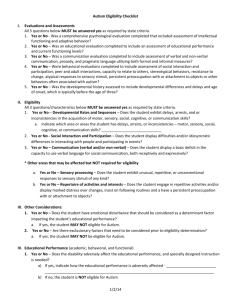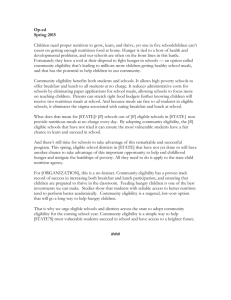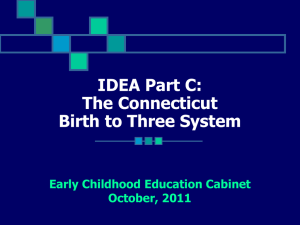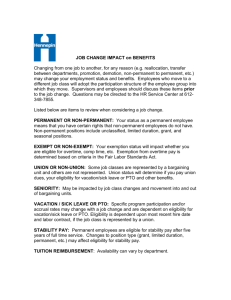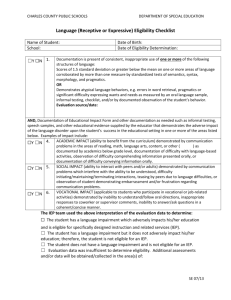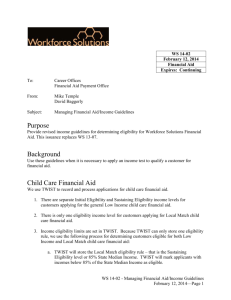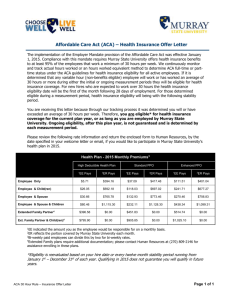Evaluation - Connecticut Birth to Three System
advertisement
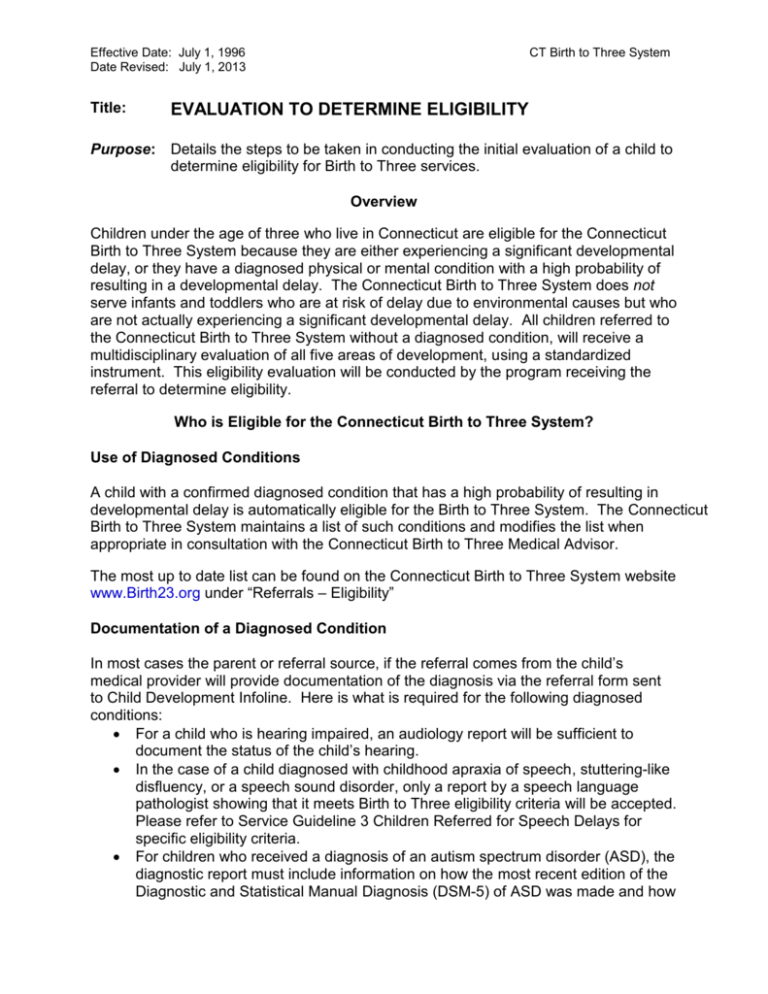
Effective Date: July 1, 1996 Date Revised: July 1, 2013 Title: CT Birth to Three System EVALUATION TO DETERMINE ELIGIBILITY Purpose: Details the steps to be taken in conducting the initial evaluation of a child to determine eligibility for Birth to Three services. Overview Children under the age of three who live in Connecticut are eligible for the Connecticut Birth to Three System because they are either experiencing a significant developmental delay, or they have a diagnosed physical or mental condition with a high probability of resulting in a developmental delay. The Connecticut Birth to Three System does not serve infants and toddlers who are at risk of delay due to environmental causes but who are not actually experiencing a significant developmental delay. All children referred to the Connecticut Birth to Three System without a diagnosed condition, will receive a multidisciplinary evaluation of all five areas of development, using a standardized instrument. This eligibility evaluation will be conducted by the program receiving the referral to determine eligibility. Who is Eligible for the Connecticut Birth to Three System? Use of Diagnosed Conditions A child with a confirmed diagnosed condition that has a high probability of resulting in developmental delay is automatically eligible for the Birth to Three System. The Connecticut Birth to Three System maintains a list of such conditions and modifies the list when appropriate in consultation with the Connecticut Birth to Three Medical Advisor. The most up to date list can be found on the Connecticut Birth to Three System website www.Birth23.org under “Referrals – Eligibility” Documentation of a Diagnosed Condition In most cases the parent or referral source, if the referral comes from the child’s medical provider will provide documentation of the diagnosis via the referral form sent to Child Development Infoline. Here is what is required for the following diagnosed conditions: For a child who is hearing impaired, an audiology report will be sufficient to document the status of the child’s hearing. In the case of a child diagnosed with childhood apraxia of speech, stuttering-like disfluency, or a speech sound disorder, only a report by a speech language pathologist showing that it meets Birth to Three eligibility criteria will be accepted. Please refer to Service Guideline 3 Children Referred for Speech Delays for specific eligibility criteria. For children who received a diagnosis of an autism spectrum disorder (ASD), the diagnostic report must include information on how the most recent edition of the Diagnostic and Statistical Manual Diagnosis (DSM-5) of ASD was made and how Evaluation page 2 the child performed in the core deficit areas of ASD. This diagnosis can be made by a physician, licensed social worker or licensed clinical psychologist. Developmental Delay Definition The eligibility criteria for a developmental delay is defined in Connecticut as being 2 SD (standard deviations) below the mean in one of the following developmental areas or 1.5 SD below the mean in two or more of the following areas: A. B. C. D. E. cognitive development physical development including vision, hearing, motor and health development communication development social or emotional development adaptive skills development (also known as self-help or daily living skills) Developmental Delay can be substantiated by: Standard deviation scores meeting eligibility criteria following evaluation by two professionals who meet the Connecticut Birth to Three Personnel Standards to complete evaluations, or One professional who holds two certifications or licenses that meet the Connecticut Birth to Three Personnel Standards to complete evaluations, or Documentation of standard deviation scores meeting eligibility criteria from current (within 3 months) medical or other report, or Clinical opinion substantiated by two professionals, or one professional who is qualified in more than one discipline/profession, using objective criteria to determine that the child’s delays meet the eligibility criteria. Use of Medical Records in Eligibility Determination Section 303.321(a)(3)(i) of the Part C regulations state that “a child’s medical and other records may be used to establish eligibility (without conducting an evaluation of the child)”. Therefore, if an program obtains written results of an existing evaluation(s), this may be used to determine the child’s eligibility if the following conditions are met (1) they were completed within the past three months,(2) they were conducted by qualified personnel (i.e. they meet the requirements of the Connecticut Birth to Three Personnel Standards), and (3) provide information from a normed standardized instrument that confirms the child is eligible due to a significant developmental delay of minus 2 standard deviations in one area or minus 1.5 standard deviations in two areas. If the program receives a report that meets these conditions then a standardized instrument is not required to determine eligibility and the multidisciplinary team can move forward to complete the initial assessment in all five areas of development (see assessment procedure). Use of Informed Clinical Opinion to Determine Eligibility Infrequently, standardized instruments cannot be completed because they: Evaluation page 3 are not applicable due to an infant’s age or significant illness would require significant adaptation for a child to perform the items, thereby invalidating the results When this is the case, the informed clinical opinion of at least two qualified professionals from different disciplines or one professional who is qualified in more than one discipline/profession may be used to substantiate the equivalent delay of 2 SD below the mean in one area of development or 1.5 SD below the mean in two areas of development. Record the reason in the Notes section in the Birth to Three Data System. Some standardized tests have large age intervals (e.g. six months), a child whose age is just short of the next age interval may have standard scores indicating that he or she is not eligible. Rather than using informed clinical opinion in this instance, it would be advisable to use an instrument with shorter age intervals. The Battelle Developmental Inventory 2nd edition (BDI 2), for example, uses one month intervals for scoring for the first 24 months. Additionally use of a domain specific tool in the area of concern (for example: Alberta Infant Motor Scale for infants with motor concerns or Preschool Language Scale 5 for toddlers with language concern) may yield valid standardized information that confirms the eligibility determination, in addition to the multi-domain tool. A child who is initially determined eligible for the Birth to Three System by informed clinical opinion of developmental delay must be re-evaluated within six months using a standardized instrument to document that the child is exhibiting a developmental delay of 2 SD below the mean in one area of development or 1.5 SD below the mean in two areas of development. Do not change the eligibility status in the data system. Instead make a note with the date of the confirmed determination. If the child is not eligible based on the results of the re-evaluation, the child should be exited from the system within the month or sooner with parent agreement noting Completion of IFSP as the reason. Birth to Three Medical Advisor Providers who have any questions about a child’s eligibility may contact the Birth to Three Child Find Coordinator to request a review by the Birth to Three System’s medical advisor. Special Circumstances Eligibility for Children with Delays in Speech Only A child whose delay in the area of expressive communication is at least 2 SD below the mean, but whose combined score in the communication domain is not at least 2 SD below the mean, is eligible if one of the following risk factors (as determined by a speech pathologist) is also present: 1. Oral motor disorders Evaluation page 4 2. 3. 4. 5. 6. Moderate to severe phonological impairment (fewer than 65% of consonants correct in a 5 minute continuous speech sample) Chronic otitis media for duration of six months or longer Family (parents or sibling) history of language impairment or developmental delay Significant birth history including: congenital infection; craniofacial anomalies including cleft lip; birth weight less than 1500 grams; hyperbilirubinemia at a level requiring exchange transfusion; ototoxic medications; bacterial meningitis; Apgar scores of 0-4 at one minute and 0-6 at five minutes; mechanical ventilation lasting more than five days; head trauma associated with loss of consciousness or skull fracture. Ongoing concerns by the family or the evaluator about the child’s qualitative performance in the areas of social/emotional or interpersonal skills and/or play interest and/or sensory domains. The presence of one of the above biological factors must be documented either through medical records, additional assessment, or through behavioral observations. In the case of family history of language impairment or developmental delay, family report is acceptable. In order to adequately weigh these factors, one of the evaluators must be a speech and language pathologist. When a child’s speech or language is delayed, it is critical that the child’s hearing be screened or evaluated by an audiologist as soon as possible upon beginning early intervention services. Standardized instruments used to determine a child’s level of development for eligibility typically include very few items in expressive communication. If the child’s delay is in expressive communication only and the child was not found to be eligible based on the developmental evaluation using a multi-domain instrument (e.g. BDI II), then the program must also use a standardized speech and language instrument such as the most current version of the Preschool Language Scales (PLS) or send out a speechlanguage pathologist before the result of the eligibility evaluation is determined. The speech specific tool must be administered by a speech language pathologist or someone who has been trained in use of the tool. It is possible that a child showing a mild delay in speech on a multi-domain test that does not have many items in the expressive communication area (for example the Battelle 2) may show a significant delay when tested on the PLS. The information from the PLS is a more accurate measure of eligibility in the area of speech than a standardized multi-domain test of development. For children who live in homes in which English is not the primary language, the evaluator must be able to demonstrate that the child has a significant delay in communication in his or her primary or dominant language. This often involves using an interpreter to obtain an accurate evaluation. Caution is advised when determining eligibility for such children using evaluation tools designed for English-speaking children. Such scores should not be reported, but should only be used to help the evaluator form a clinical opinion of the child’s degree of delay. Some language evaluations such as the Preschool Language Scale Evaluation page 5 Spanish are normed for young Spanish-speaking children and even adjusted for different dialects. Children recently adopted from a non-English speaking country will not be eligible due to a significant delay in spoken English communication until at least six months postadoption. They should be given a complete multidisciplinary developmental evaluation using their native language, if possible, which may identify significant delays in areas other than communication. For further information about intervention and eligibility for children with speech delays, including use of an interpreter, refer to Service Guideline #3: Children Referred with Speech Delays (2013 Revision). Eligibility for Children with Motor Delays While neither gross nor fine motor is actually listed separately as part of the developmental area of physical development in the IDEA Part C regulations (34 CFR 303.21(a)(1), for purposes of eligibility, the Connecticut Birth to Three System considers them to be separate developmental areas. Therefore, a child with a delay of 2 or more standard deviations below the mean in either gross or fine motor is eligible. Consequently, a child with a delay of 1.5 SD below the mean in both gross and fine motor is also eligible. If the child’s area of concern is in motor and the child was not found to be eligible based on use of a multi-domain evaluation tool, then the program must also complete the most current version of a standardized motor specific instrument (such as the Alberta Infant Motor Scale or Peabody Motor Scales) or send out a motor therapist before the result of the eligibility evaluation is determined. The motor specific tool must be administered by a motor therapist or someone who has been trained in use of the tool. For a child with concerns in the motor area it is recommended that the medical history of these children be considered along with other early signs of motor dysfunction in the areas of their reflexes, tone, posturing, decreased motor activity, decreased movement variability. This information along with objective information from the evaluation tools could result in determining that a child with undiagnosed neurological disorder is eligible due to clinical opinion. In order to adequately weigh these factors, one of the evaluators must be an Occupational or Physical therapist Children Born Prematurely For children born prematurely, an adjusted age should be used only when directed by the administration/scoring directions of the chosen instrument(s). Additionally, it is recommended that the medical history of these children be considered along with other early signs of motor dysfunction. This information along with objective information from the evaluation tools could result in determining that a child with undiagnosed neurological disorder is eligible due to clinical opinion. Evaluation page 6 Eligibility for Children Moving to New Families Ideally the initial evaluation of a child who has moved to a new family, either through foster placement or international adoption, should be postponed for at least a month until the child is able to acclimate to the new people, surroundings, food, and schedule (unless the child has a diagnosed condition or a very obvious disability). Children in foster care have experienced some kind of significant family disturbance and are at risk for social/emotional delays. Please check the Infant Mental Health guidelines for more information on examples of behaviors that signal concerns and specific social/emotional assessment tools to assist in determining eligibility. Eligibility for Children Who Move to Connecticut Children who move to Connecticut from another state where they were eligible due to being “at risk” for a developmental delay, will not be eligible for Connecticut Birth to Three services unless the child is currently demonstrating a significant developmental delay. Children who move to Connecticut from another state where they were deemed eligible because of a diagnosed condition or because they were significantly delayed at the time of their referral to the other state’s program (e.g. 2 SD or 30% delay in one area or 1.5 SD or 25% delay in two areas) are eligible for services in Connecticut unless they are functioning within normal limits in all five areas of development (see Exit procedure). Current information (if not older than three months) sent from the child’s previous early intervention program can be used to determine eligibility. If this information is not available, the program will need to conduct an eligibility evaluation to determine whether the child is currently on age level in all areas or whether he is still demonstrating a delay. If eligible, the child will need to have a multidisciplinary assessment completed for program planning purposes and an initial IFSP developed. The Connecticut Birth to Three System is not required to provide Part C early intervention services to a child who is also receiving Part C early intervention services in another state if that child and their family are only temporarily visiting in Connecticut. This does not apply to children who are homeless or whose family is highly mobile (e.g. migrant workers) or displaced by a catastrophic event such as a hurricane or flood, who are wards of the state, or who reside on an Indian reservation. The Initial Evaluation Process Initial Contact A program will contact the family within one working day of receiving a referral and provide the name of the person who will be acting as service coordinator to facilitate the evaluation, and or the assessment. If the family does not have a phone they will be contacted by mail. The service coordinator who contacts the family will review the referral information that was received, explain the evaluation and assessment process Evaluation page 7 and discuss the importance and required involvement of the family, caregivers and primary health care provider in this process. The eligibility evaluation must be completed by: at least two qualified professionals from different disciplines or one professional who is qualified in more than one discipline/profession or one professional who verifies the acceptability of a medical report documenting developmental delay that meets CT Birth to Three eligibility criteria. The team members should be selected based on the child’s needs (e.g. a speech pathologist should be part of the team evaluating a child referred for communication concerns). Personnel who are qualified to evaluate for eligibility are those professionals identified in the Connecticut Birth to Three Personnel Standards who have current certification, licensure, or comparable requirements of their profession. Parents are required to actively participate in the initial evaluation and will be asked where and when the evaluation should take place. The evaluation should be scheduled in the home or in another location familiar to the child in order to elicit the best responses from the child. However, if an evaluation is scheduled using this information and the family is not there when the team arrives, all subsequent attempts to evaluate the child will be scheduled at a location convenient to the evaluators. If either of the parents who will participate in the evaluation is of limited English proficiency, the service coordinator must ensure that an interpreter will be present. If parents are not active participants valuable information may be missed, families may not assume ownership of decisions made or interventions planned and families may not feel like part of the team. Parent participation may take many forms, based on the family’s perceptions of what is appropriate and important. These perceptions will be shaped by their cultural backgrounds, economic status, and value system as well as the assessor’s attitude and communication skills. Part of the evaluation process must be the consideration of the parent’s preference for their role in the evaluation. Those roles, as described on a continuum from most involved to least involved are: demonstrating validating interpreting informing observing the parent, at the assessor’s request, has the child demonstrate various skills the parent validates for the assessor that the child’s behavior on a test item is or is not typical the parent can interpret for the assessor, “oh, when he does that it means… or “saying ‘ba’ means he wants his baby doll” the parent provides information about what the child can and cannot do the parent watches as the assessor administers test items This information is also explained to parents in the Family Handbook: Guide I as various ways that the evaluation team may ask them to participate. The service coordinator will ask the parent if previous evaluations of the child have been completed that may help for documentation of a diagnosed condition that affects Evaluation page 8 eligibility or assessments that may help in determining the child’s present abilities. A signed release, Form 3-2, to obtain written information and to speak with the child’s primary health care provider will be obtained at this first meeting. The service coordinator will ask the parent for authorization to share the result of the evaluation with the child’s primary health care provider using Form 3-3 to support ongoing care coordination by the medical home. Written Prior Notice Section 303. 21 of the IDEA Part C regulations states that, prior written notice must be provided to parents a reasonable time before the lead agency or a provider proposes, or refuses, to initiate or change: the identification evaluation placement of their infant or toddler the provision of early intervention services to the infant or toddler with a disability and that infant’s or toddler’s family For this reason, parents must receive prior written notice (Form 1-6) before a program conducts an initial evaluation (see Procedural Safeguards procedure) and after the completion of the evaluation, whether the child is found eligible or not eligible. Obtaining Consent for Evaluation Written consent for the evaluation must be obtained from a parent, surrogate parent, or legal guardian prior to beginning the evaluation using Consent for Evaluation/Assessment Form 1-4. Written consent is specific to the evaluation instrument(s) listed. The program should only list those instruments that will be used at the initial evaluation or can list all possible instruments and only check those to which the parent is actually consenting. Listing all possible evaluation instruments on every consent form is not appropriate. If the parent has consented to the use of certain instruments and once on-site, the evaluators decide that a different instrument would also be useful, they should obtain consent for that additional instrument on an additional Form 1-4. The names of instruments should be spelled out on the form and not abbreviated. If the parent or legal guardian refuses to give their consent for the initial evaluation, the service coordinator will make a reasonable effort to ensure that the parent is fully aware of the nature of the evaluation and understands that the child will not be able to receive an evaluation, or services, unless consent is given. If a parent refuses to consent to evaluation in circumstances where lack of services constitutes child abuse or neglect, the service coordinator is required to make the necessary report to the Department of Children and Families, using DCF Form -136 (see Abuse and Neglect procedure). There are some cases where there may be divorce or separation issues or questions about which parent is legally able to give consent for an initial evaluation. Typically either parent can give written consent for an evaluation. The exceptions are: Evaluation page 9 When one parent’s parental rights have been terminated OR If there is a State Court custody order that either requires that decisions be made jointly OR The custody order gives sole decision-making authority to one of the parents Regardless of who has decision-making authority, the program must send written prior notice and a copy of the evaluation report to both parents unless one parent’s rights have been terminated. Child Development Infoline (CDI) will ask all parents upon referral whether there are any custody issues regarding decision making that the program needs to know about. If the parent says “yes”, CDI will ask whether they have sole or joint custody, and if there is a parent at another address who should receive the evaluation report. CDI will list this information, including the second parent’s address, in the notes section on the referral screen of the data system. If CDI has flagged the issue, the person who schedules the evaluation should confirm the information when they call to schedule. If the referring parent has indicated that joint decision-making is required, the program should send the evaluation consent form out ahead of time so that both signatures can be obtained. If there is another parent listed at a separate address, both the written prior notice of the evaluation and the evaluation report must be sent to that second parent. Sometimes one parent may request the evaluation without telling the other parent. Only one parent’s consent is needed to proceed with an evaluation unless there is legal documentation indicating that joint decision-making is required. If both parents decide to decline the evaluation when contacted by the program to schedule the eligibility evaluation or when the evaluation team arrives to complete the evaluation, the program will indicate that the parent declined the evaluation in the Birth to Three data system. The program will inform the parents of their right to re-refer their child at any time. Completing the Evaluation No single procedure (standardized testing, observation, parent interview, review of medical information, others) may be used as the sole criterion to determine eligibility. The team will evaluate all five developmental areas including cognition; physical (including fine and gross motor, vision, and hearing); communication (including receptive and expressive); social/emotional; and adaptive using a multi-domain standardized instrument. The instrument should be used in its entirety. Other instruments targeting specific domains should also be used when appropriate. Prior to determining a child ineligible when only using a multi-domain tool, a tool more specific to the referral concern must also be used (see Special Circumstances section of this procedure for more information). If an eligibility evaluation and assessment cannot be completed in sufficient time to ensure that the IFSP meeting is held within 45 days of referral, the service coordinator will document the reasons in the child’s early intervention record and the data system. Evaluation page 10 Evaluating Hearing and Vision Parent report can provide vision and hearing screening information (also see Form 3-17 Birth to Three Vision Screening) but for eligibility purposes, documentation of visual impairment or hearing loss must be by doctor or audiologist report. It is critical that the child’s hearing be screened or evaluated by an audiologist before beginning early intervention services when speech or language is delayed. If the status of the child’s hearing or vision is in question then programs must assure that this is addressed in the IFSP. Any previous audiological testing or screening results, including newborn hearing screening, are only valid for one year. If current testing indicates a hearing loss, the program must address that in the child’s IFSP. For vision, unless the child’s physician has specifically evaluated the child’s vision, the assessor should use Form 3-17 “Birth to Three Vision Screening”. If any items on the screen are answered “yes”, a copy of the results with a cover letter should be sent to the child’s physician, with parent consent, for follow-up. Choice of Program Each Birth to Three program is responsible, after determining that a child is eligible, to give the family objective information on all available programs in their geographic area. They must allow the family to decide if they wish to receive services from their program or select another. This includes children with hearing loss or deafness, or an autism spectrum disorder, whose parents may choose a specialty program or general program to provide their supports. If another program is selected, the service coordinator will contact either the program director or Child Development Infoline to determine whether that program is accepting referrals. If not, the original program should help the family select a program that is accepting referrals. After obtaining a written release from the parent using Form 3-3, the original program should send all records to the new program and complete the electronic transfer operations in the Birth to Three data system. Children Determined Not Eligible Parents of children evaluated and found not eligible should receive Prior Written Notice (Form 1-6) and a written explanation of the decision within four days. See the Dispute Resolution Regarding Eligibility section of this procedure if the parent is not in agreement with this decision. It is important to note that a child may not meet the Birth to Three eligibility requirements but still show some degree of delayed development, this information should be conveyed to the parents and included in the evaluation report. If there are still concerns about the child’s development, the parent may request a new eligibility evaluation three months after the last evaluation by contacting Child Development Infoline. The parent may request a new evaluation be completed sooner than three months from the last evaluation if there is a significant change in the child’s development or health status. When a second evaluation is requested the parent may choose to have the original program complete the evaluation or request a different program if one is available. Evaluation page 11 With written consent of the parents, children who are evaluated and found to be not eligible will be offered developmental monitoring through the Ages and Stages Questionnaires (administered by the Help Me Grow Program) and will also be referred to other appropriate community resources and programs. If the child who is not eligible for Birth to Three is suspected to need mental health services, the parent should be referred back to Child Development Infoline/Help Me Grow for referral to a licensed mental health professional. In all cases, the phone number for such referrals is 1-800-505-7000. Dispute Resolution Regarding Eligibility If a parent disagrees with the eligibility determination they are encouraged to: 1. Discuss with the evaluator(s) how their child’s abilities and needs compare with Connecticut’s eligibility criteria. 2. Offer new information to the evaluator(s), such as a recent medical diagnosis that might affect eligibility. 3. Contact the Child Find Coordinator and request that the eligibility decision be reviewed; or 4. Send a written complaint or a request for a hearing to the Birth to Three Director if they feel there were problems with evaluation process. If a parent calls the Child Find Coordinator or files a written complaint, the following process will be followed: 1. The Child Find Coordinator will request a copy of the evaluation and any other available information from the program. 2. The Child Find Coordinator and the Birth to Three medical advisor may review the evaluation report and supporting documentation. 3. If, during the course of the review, it is discovered that information was overlooked or the evaluation process was flawed, the program will be asked to re-consider the eligibility determination in light of the new information or to reevaluate the child. Evaluation Report Parents of children evaluated and determined to be eligible should receive a written statement of eligibility within four days of the evaluation. This may be done by giving a draft of the evaluation report or it may be just a one page summary form or a visit note. Regardless of the format, the statement must explain clearly why the child was determined to be eligible or not eligible. Parents must also receive prior written notice (Form 1-6) after the completion of the evaluation, whether the child is found eligible or not eligible, (see Procedural Safeguards procedure) Whether or not the child was found eligible, each eligibility evaluation and assessment must result in one typed report. The report should address the child’s development in Evaluation page 12 all five areas as required by IDEA but should use descriptions of the child’s functioning within daily activities, rather than a report limited to descriptions of items the child passed or failed on various tests. It is appropriate to include standard scores when available with an explanation so that the parents understand the meaning of the scores. When the results of the eligibility evaluation are combined with an assessment, the report should provide comprehensive, detailed, strength-oriented information about the child’s abilities, areas of concern or readiness, learning style, environmental demands, adaptations, and next steps in development. All reports should be written in a way that is useful to the parents, avoiding use of jargon. The report must also include the following: 1. The program name, address, child name, parent’s names, address, DOB, and age at the time of the evaluation 2. The date of the evaluation. 3. The location of the evaluation. 4. A description of the process and instruments used to complete the evaluation. 5. A description of the child and family’s daily routines. 6. Language that describes the family’s input and how they participated in the evaluation process. This involvement should be evidenced throughout the report by referencing the parent(s) role using one or more of the categories provided on the preceding pages. 7. Child’s strengths, areas of concern and next steps in development. 8. Current levels of functioning across all five areas of development (cognitive, physical -including vision, hearing, motor and health, communication, social or emotional, and adaptive skills, also known as self-help or daily living skills). 9. A clear statement of the specific reason(s) why the child was determined to be eligible or not. 10. Original signatures on the same page along with the credentials of: two qualified Birth to Three personnel from two different disciplines or one Birth to Three evaluator who is qualified in more than one discipline/profession or one Birth to Three professional who confirmed an acceptable diagnosed condition or one Birth to Three professional stating that an existing report confirmed a significant developmental delay as defined by Connecticut’s Birth to Three System The dates of the signatures should correspond with the date of the report not the date of the evaluation unless the report was written on the date of the evaluation. Prior to the evaluation report being finalized, the parents should have an opportunity to review it with one of the team members to be sure they are in agreement. If the parents have additional information or request any changes, the report should be modified to reflect their input. A final copy is given to the family and filed in the child’s record. To the extent feasible, families with limited proficiency in English should receive a summary of the written report in their native language. The service coordinator will ask the parents for written consent to release the final report to the child’s primary physician (Form 3-3) and the referral source if that is different from the family or primary physician. Permission to release report should not Evaluation page 13 be requested until the parent has had a chance to read it at least in draft form. Evaluation information, including whether the child is eligible, may not be shared with anyone, including the referral source, without the parent’s written consent. Information Specific to Autism Spectrum Disorders Screening Children for Autism Spectrum Disorders (ASD) The American Academy of Pediatrics recommends that children be screened for an ASD twice before their second birthday. The Connecticut Birth to Three System requires that all children referred to the Birth to Three System who are 16 months of age (adjusting for prematurity up to two years of age) or older and do not have a prior positive screen or a diagnosis of autism will be screened for ASD as part of the intake process. This will be explained to the parent and completed even if the parent and/or referral source have no concerns about autism. All screening and evaluation done by Birth to Three is voluntary and requires written consent. If the parent chooses not to have their child screened, the evaluation team must document that the parent refused consent in their evaluation report. Preferred screening instruments include the Modified Checklist for Autism in Toddlers (M-CHAT) and the Brief Infant Toddler SocialEmotional Assessment (BITSEA). If there are questions about the child’s overall communication development and the program chooses to use the Communication and Symbolic Behavior Scales Developmental Profile (CSBS DP Infant-Toddler Checklist), the results may be used in lieu of conducting an autism screening. Children Found Not Eligible for Birth to Three services due to developmental delay although the screening indicates there is concern about ASD When a child is not eligible due to developmental delay but the autism screen indicates the presence of critical behaviors that may indicate an autism spectrum disorder, the family will be given the opportunity to have one of the autism-specific programs conduct further assessment to determine if the child meets the diagnosis of autism as determined by the current Diagnostic and Statistical Manual, (DSM 5). If the autism assessment indicates the existence of an autism spectrum disorder, then the child is eligible for the Birth to Three System. The family will then need to choose to have their child receive services from an autism-specific program or a general program that serves their town. Determining if a Child is Eligible for Birth to Three due to a diagnosis of Autism Spectrum Disorder When the autism screen indicates the presence of critical behaviors that may indicate an autism spectrum disorder, the family will be given the opportunity to have one of the autism-specific programs conduct further assessment to determine if the child meets the diagnosis of autism as determined by the latest version of the Diagnostic and Statistical Manual (DSM-5). All of the autism-specific programs are equipped to make this diagnosis. In some cases they may be made by the general program provided that one of the evaluators is a physician, licensed clinical social worker, or licensed clinical psychologist. This determination process will consist of: Evaluation page 14 1. An in-depth review of the autism screening that was completed to confirm the “red flags” identified as part of the screening. This may be done as part of the original screening completed by the Birth to Three program. 2. A review of the child’s health information to determine if the child’s hearing has recently been screened or evaluated to rule out a possible hearing loss. 3. A review of assessments previously completed on the child to assure that the child demonstrates a delay greater than 1 standard deviation below the mean in receptive language, expressive language, social-emotional or adaptive behavior skills. If needed, additional developmental assessments such as a Vineland Adaptive Behavior Scales or the Preschool Language Scales 5th Edition (PLS 5) should be completed to give a full picture of the child. 4. If it is determined that there is a need for further assessment, the administration of a validated assessment measure such as the most recent version of the Autism Diagnostic Observation Schedule (ADOS-2), for children 12 months and older, the Autism Diagnostic Interview-Revised (ADI-R), for children 24 months and older, or the Childhood Autism Rating Scale (CARS) (2+ years) by a professional or professionals with appropriate training will be completed. Children who Receive a Diagnosis of ASD Prior to Referral or Have an Outside Evaluation for ASD For children who have received a diagnosis of ASD prior to a referral being is made, Child Development Infoline will offer the family a choice of one of the autism-specific programs or one of the general programs serving their town of residence. The program that receives the referral will first confirm that sufficient information on the diagnosis is available (see Documentation of a Diagnosed Condition section of this procedure). Since the child is already known to be eligible because of a diagnosed condition, whichever program receives the referral will perform an initial multi-disciplinary assessment in all five developmental domains and a family assessment prior to developing the initial IFSP. Children referred due to a concern that the child may have ASD, but a diagnosis has not been made If a child has been screened or determined by a doctor to have a high risk of having an autism spectrum disorder, the children will be referred directly to an autism-specific program by Child Development Infoline. The autism-specific program must determine 1) whether the child is eligible for Birth to Three based on developmental delay and/or 2) whether the child has a DSM-5 diagnosis of ASD. If a child is determined to have the DSM-5 diagnosis of ASD, the parent will be offered the choice of remaining with the autism-specific program, choosing a different autism-specific program that serves their town, or choosing one of the general Birth to Three programs that serves their town, as long as the program they choose is accepting new referrals. If the child is eligible due to developmental delay but is not determined to have a diagnosis of ASD, the family will be offered a choice of one of the general Birth to Three programs that serves their town. Evaluation page 15 If the child is neither eligible due to a developmental delay nor determined to have a diagnosis of an autism spectrum disorder, the parents will be told that the child is not eligible and offered resources outside of the Birth to Three System, such as Help Me Grow’s Ages and Stages Questionnaire (a developmental monitoring and resource referral program for children at-risk). If the child who is not eligible for Birth to Three is suspected to need mental health services, the parent should be referred back to Child Development Infoline/Help Me Grow for referral to a licensed mental health professional. In all cases, the phone number for such referrals is 1-800-505-7000. __________________________ References: Form 1-4, Consent for Evaluation/Assessment Form 1-6, Prior Written Notice Form 3-2, Authorization for Programs to Obtain Information Form 3-3, Authorization for Programs to Release Information Form 3-17, Birth to Three Vision Screening Part C of IDEA Sec. 1432 (5) 34 CFR Section 303.321 17a-248e (e) of the C.G.S. Section 17a-248-1 (16) of the Regulations of CT State Agencies Service Guideline #3, Children Referred with Speech Delays Service Guideline #1, Autism Spectrum Disorder Exit Procedure Ages and Stages Questionnaire Personnel Standards Procedural Safeguards Procedure
